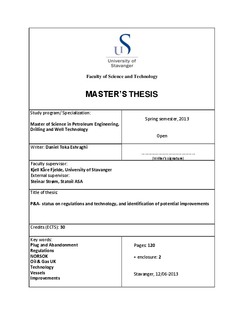| dc.description.abstract | There will be a wave of wells needing to be abandoned in the North Sea over the next decades. The abandonment operation is known as Plug and Abandonment, or just P&A. As P&A has no value creation, it is very important that these operations are conducted as effective as possible. Currently, operations are mainly completed using conventional methods, and for P&A to be economically sustainable in the future there is a great need for new technology and methods. In addition, regulators can play a part in achieving more effective operations by tailoring requirements and guidelines. In Norway, P&A operations are still based on a standard released in 2004, meaning that there is a potential for improvements.
In this thesis the standard that governs P&A operations in Norway was analysed and compared with the guidelines used on UK sector to find ways of improving NORSOK D-010. UK sector has more experience with regards to P&A, and use a guideline published in 2012. This ended in several proposed changes in NORSOK D-010, but also suggestions for additional guidelines for the NCS.
To show how alternative technology and methods can be used to improve P&A operations several solutions were presented, including all phases of well abandonment, both for platform and subsea wells. In addition rigs and vessels used in P&A were described, as one of the most important future goals is performing operations rigless. For platform P&A the goal is performing offline operations, meaning eliminating the use of the derrick. For subsea abandonment there exist a great potential in moving operations away from the traditionally used semi-submersibles, and to smaller and significantly cheaper light well intervention vessels (LWIs). Technology and vessels use were later combined in several example cases to give an overview over how operations can improve. In the future operators must be willing to utilize alternative technology in the field, and continue to push for research and development on newer technology to solve the many challenges in P&A operations. | no_NO |
